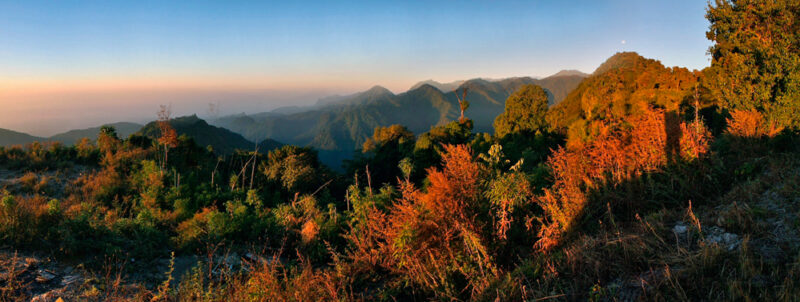Eaglenest Wildlife Sanctuary, located in the eastern Himalayas, is a haven for nature enthusiasts and wildlife lovers. This vast sanctuary is nestled amidst the pristine forests of Arunachal Pradesh, India. With its incredible biodiversity and breathtaking landscapes, Eaglenest Wildlife Sanctuary offers a unique opportunity to explore the wonders of the Eastern Himalayas.
Table of Contents
- Location and Overview
- Flora and Fauna Diversity
- Avifauna: A Birdwatcher’s Paradise
- Mammals of Eaglenest Wildlife Sanctuary
- Reptiles and Amphibians
- Floral Treasures: Orchids and Rhododendrons
- Ecotourism and Conservation Efforts
- Trekking and Nature Trails
- Exploring the Eaglenest Wildlife Sanctuary
- Accommodation and Facilities
- Best Time to Visit
- How to Reach Eaglenest Wildlife Sanctuary
- Conservation Challenges and Initiatives
- Conclusion
Location and Overview
Eaglenest Wildlife Sanctuary spans an area of approximately 218 square kilometers and is situated in the West Kameng district of Arunachal Pradesh. It is perched at an elevation ranging from 500 meters to 3,250 meters above sea level. The sanctuary derives its name from the Red Eagle Division of the Indian Army, which was stationed here during World War II.
Flora and Fauna Diversity
The sanctuary boasts a remarkable range of flora and fauna, owing to its location in the Eastern Himalayas, one of the world’s biodiversity hotspots. It is home to more than 454 bird species, 165 butterfly species, 71 mammal species, and numerous reptiles, amphibians, and insects.
Avifauna: A Birdwatcher’s Paradise
Eaglenest Wildlife Sanctuary is a paradise for birdwatchers, offering unparalleled opportunities for bird sighting. The sanctuary is particularly renowned for its diversity of bird species, including rare and endangered ones. Visitors can spot colorful birds such as the Beautiful Nuthatch, Ward’s Trogon, Rufous-necked Hornbill, and the globally threatened Bugun Liocichla.
Mammals of Eaglenest Wildlife Sanctuary
The sanctuary is home to a diverse array of mammal species, both large and small. Wildlife enthusiasts can spot charismatic mammals such as the Red Panda, Clouded Leopard, Asian Elephant, and the elusive Bengal Tiger. Other notable mammals found here include the Himalayan Black Bear, Leopard, and various species of deer and primates.
Reptiles and Amphibians
Eaglenest Wildlife Sanctuary is also a haven for reptiles and amphibians. The region’s moist and humid climate supports the thriving populations of various snakes, lizards, frogs, and salamanders. Some of the notable reptiles and amphibians found here include the King Cobra, Asian Pit Viper, Boulenger’s Lazy Toad, and the rare Arunachal Torrent Frog.
Floral Treasures: Orchids and Rhododendrons
The sanctuary is adorned with an enchanting variety of flora, including numerous species of orchids and rhododendrons. These vibrant flowers add a splash of color to the lush green landscape of Eaglenest Wildlife Sanctuary. Visitors can witness the breathtaking beauty of orchids like the Slipper Orchid, Lady’s Slipper Orchid, and the exquisite Blue Vanda.
Ecotourism and Conservation Efforts
Eaglenest Wildlife Sanctuary promotes sustainable ecotourism practices to ensure the preservation of its delicate ecosystem. Local communities actively participate in conservation initiatives, and their efforts have contributed to the sanctuary’s biodiversity conservation. Ecotourists can engage in various activities like birdwatching, nature walks, and guided tours to appreciate the sanctuary’s natural wonders.
Trekking and Nature Trails
For adventure seekers, Eaglenest Wildlife Sanctuary offers numerous trekking and nature trails that meander through its picturesque landscapes. These trails provide opportunities to explore the sanctuary’s hidden gems, spot wildlife, and immerse oneself in the serenity of nature. Trekking enthusiasts can embark on trails like the Sessni Trek, Bugun Trek, and the Eaglenest Pass Trek.
Exploring the Eaglenest Wildlife Sanctuary
While exploring Eaglenest Wildlife Sanctuary, visitors can experience the magic of the Eastern Himalayas up close. They can witness breathtaking views of snow-capped peaks, cascading waterfalls, and meandering rivers. The sanctuary’s dense forests house a myriad of wildlife, ensuring a memorable encounter with nature.
Accommodation and Facilities
Several eco-lodges and guesthouses are available near Eaglenest Wildlife Sanctuary, providing comfortable accommodation options for visitors. These establishments offer basic amenities and a chance to experience the local culture and hospitality. It is advisable to make prior reservations, especially during the peak tourist season.
Best Time to Visit
The best time to visit Eaglenest Sanctuary is during the months of October to April when the weather is pleasant, and the chances of wildlife sightings are higher. The sanctuary experiences heavy rainfall during the monsoon season, which makes it challenging to explore the region.
How to Reach Eaglenest Wildlife Sanctuary
Eaglenest Sanctuary can be reached by road from Tezpur, Assam, which is the nearest major city. Tezpur has good connectivity with other cities in India. From Tezpur, one can hire a private vehicle or take a shared taxi to reach the sanctuary. The journey takes approximately six to seven hours, covering a distance of around 180 kilometers.
Conservation Challenges and Initiatives
Eaglenest Sanctuary faces several conservation challenges, including habitat loss, poaching, and climate change. However, various organizations and local communities are actively engaged in conservation efforts. These initiatives focus on creating awareness, promoting sustainable practices, and preserving the sanctuary’s rich biodiversity for future generations.
Conclusion
Eaglenest Sanctuary stands as a testament to the remarkable biodiversity of the Eastern Himalayas. Its breathtaking landscapes, diverse flora and fauna, and opportunities for adventure and exploration make it a must-visit destination for nature enthusiasts. By embracing sustainable tourism and conservation practices, we can ensure the preservation of this natural treasure for generations to come.
Similar Articles
FAQs
1. Are there any restrictions on visiting Eaglenest Wildlife Sanctuary?
Visitors are required to obtain the necessary permits and permissions to enter Eaglenest Sanctuary, which can be obtained from the Forest Department. Additionally, it is important to follow the guidelines set by the sanctuary authorities to ensure the preservation of the ecosystem.
2. Can I hire a guide for birdwatching in the sanctuary?
Yes, hiring a guide is highly recommended, especially for birdwatching. The local guides are knowledgeable about the sanctuary’s avifauna and can enhance your birdwatching experience by helping you spot and identify different bird species.
3. What are the accommodation options available near Eaglenest Sanctuary?
There are several eco-lodges and guesthouses near the sanctuary that offer comfortable accommodation options. These establishments provide basic amenities and an opportunity to experience the local culture and hospitality.
4. Is it possible to spot the Red Panda in Eaglenest Sanctuary?
Yes, there have been sightings of the Red Panda in the sanctuary. However, due to its elusive nature, spotting one requires luck and patience. Engaging a knowledgeable guide can increase your chances of spotting this rare and charismatic mammal.
5. Can I visit Eaglenest Wildlife Sanctuary during the monsoon season?
It is not advisable to visit Eaglenest Sanctuary during the monsoon season (June to September) due to heavy rainfall, which makes the region inaccessible and trekking trails slippery and unsafe. It is best to plan your visit during the dry season for a more enjoyable experience.









